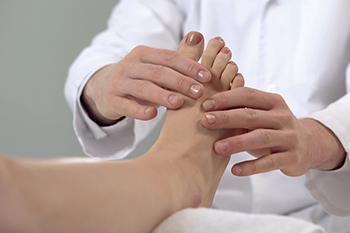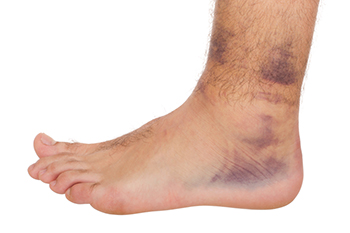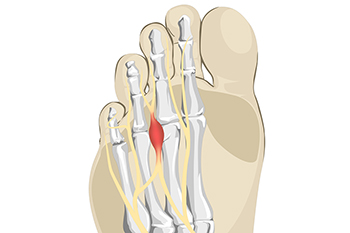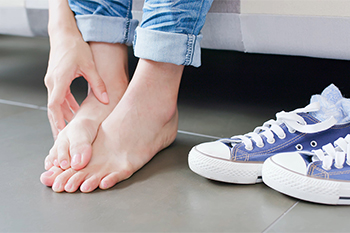Middlefield (860) 349-8500
Wallingford (203) 294-4977
Middlefield (860) 349-8500
Wallingford (203) 294-4977

A rare foot condition happens to only a few people in the population. Many rare foot conditions share symptoms with common foot problems but are harder to diagnose and treat. Three such foot diseases are Freiberg’s disease, Maffucci syndrome, and Kohler’s disease. Freiberg’s disease usually affects the second or third metatarsal bones and causes the bones to flatten and lose their normal, round, smooth shape. Symptoms include pain, swelling, and stiffness around the affected toe, and it can cause the forefoot to be tender and have a limited range of motion. Maffucci syndrome affects the skin and bones. It is characterized by multiple benign tumors in the cartilage, called enchondromas, which develop near the ends of bones and cause them to bulge and stop growing. These can lead to severe bone deformation and make bones more susceptible to fractures. This syndrome is most common among children and is rarely detected at birth, but symptoms can become apparent in the first few years of life. Kohler’s disease is another rare foot condition that happens due to the compression of the arch of the foot during a child’s early development. It affects boys more than girls and typically affects a single foot. Those with this disease have redness, swelling, and tenderness on the affected foot. Symptoms may be mild but chronic. If your child suffers from foot pain, see a podiatrist who can diagnose the problem and provide treatment.
Some foot conditions may require additional professional care. If you have any concerns, contact Dr. Gordon Fosdick of Affiliated Foot Care Center. Our doctor can provide the care you need to keep you pain-free and on your feet.
Rare Foot Conditions
The majority of foot conditions are common and can be treated by a podiatrist. Standard diagnostic procedures are generally used to identify specific conditions and treatment can be rendered. A podiatrist also treats rare foot conditions which can be difficult to diagnose and may need extra attention and care.
There are many rare foot conditions that can affect children. Some of these can include:
Freiberg’s disease - This can be seen as a deterioration and flattening of a metatarsal bone that exists in the ball of the foot. It typically affects pre-teen and teenage girls, but can affect anyone at any age. Symptoms that can accompany this can be swelling, stiffness, and the patient may limp.
Kohler’s disease - This often targets the bone in the arch of the foot and affects younger boys. It can lead to an interruption of the blood supply which ultimately can lead to bone deterioration. The patient may limp or experience tenderness, swelling, and redness.
Maffucci syndrome - This affects the long bones in a child’s foot leading to the development of abnormal bone lesions. They are benign growths and typically develop in early childhood and the bones may be susceptible to breaking.
A podiatrist can properly diagnose and treat all types of rare foot conditions. If your child is affected by any of these symptoms or conditions, please don’t hesitate to call our office so the correct treatment method can begin.
If you have any questions please feel free to contact our offices located in Middlefield and Wallingford, CT . We offer the newest diagnostic tools and technology to treat your foot and ankle needs.

Older adults are at an increased risk of developing foot problems. If you have heel pain or pain that is located at the back of your feet, chances are that it may be one of three conditions: plantar fasciitis, bursitis, or an Achilles tendon injury. Plantar fasciitis is the most common form of heel pain. This occurs when the plantar fascia tissue on the bottom of the foot gets injured or irritated and inflamed, typically through overuse. Plantar fasciitis pain is usually more intense in the morning or after periods of rest. Your podiatrist may treat it with custom orthotics, physical therapy, corticosteroid injections, shockwave therapy, or by other means. Bursitis is an inflammatory condition that affects the bursa sac between your Achilles tendon and heel bone at the back of your foot. This is a fluid filled sac that cushions joints and bones, helps protect the tendon, and reduces friction. This bursa can become inflamed, painful, swollen, or red from repetitive motions or direct pressure. The Achilles tendon can suffer from various injuries such as ruptures, tendonitis, or enthesopathy, which are typically caused by intense or repetitive strain on the tendon. If you feel any of the symptoms described here, have a podiatrist examine you and perform whatever tests are necessary to properly diagnose your condition and devise an effective treatment plan.
Many people suffer from bouts of heel pain. For more information, contact Dr. Gordon Fosdick of Affiliated Foot Care Center. Our doctor can provide the care you need to keep you pain-free and on your feet.
Causes of Heel Pain
Heel pain is often associated with plantar fasciitis. The plantar fascia is a band of tissues that extends along the bottom of the foot. A rip or tear in this ligament can cause inflammation of the tissue.
Achilles tendonitis is another cause of heel pain. Inflammation of the Achilles tendon will cause pain from fractures and muscle tearing. Lack of flexibility is also another symptom.
Heel spurs are another cause of pain. When the tissues of the plantar fascia undergo a great deal of stress, it can lead to ligament separation from the heel bone, causing heel spurs.
Why Might Heel Pain Occur?
Treatments
Heel pain should be treated as soon as possible for immediate results. Keeping your feet in a stress-free environment will help. If you suffer from Achilles tendonitis or plantar fasciitis, applying ice will reduce the swelling. Stretching before an exercise like running will help the muscles. Using all these tips will help make heel pain a condition of the past.
If you have any questions please contact our offices located in Middlefield and Wallingford, CT . We offer the newest diagnostic and treatment technologies for all your foot and ankle needs.

Bunions are a foot deformity caused by a misalignment of bones that connect at the joint of the base of the big toe. This deformity causes a bony protrusion at this joint, which then causes the big toe to lean toward the other toes, rather than pointing straight forward. Certain factors can make a person more likely to develop a bunion, such as wearing high-heeled shoes regularly, overpronating, and having certain genetic factors, loose ligaments, or other anomalies in foot structure. Aside from having an irregular appearance, a bunion can cause pain, swelling, numbness, or burning in the big toe joint and/or in the first metatarsal bone (in the forefoot). It may also be difficult to walk or find shoes that fit. It is a good idea to begin treating a bunion as soon as possible for the best results in correcting it. If you already have a fully developed bunion, or believe one is forming, make an appointment with your podiatrist for an examination and evaluation.
If you are suffering from bunions, contact Dr. Gordon Fosdick of Affiliated Foot Care Center. Our doctor can provide the care you need to keep you pain-free and on your feet.
What Is a Bunion?
A bunion is formed of swollen tissue or an enlargement of boney growth, usually located at the base joint of the toe that connects to the foot. The swelling occurs due to the bones in the big toe shifting inward, which impacts the other toes of the foot. This causes the area around the base of the big toe to become inflamed and painful.
Why Do Bunions Form?
Genetics – Susceptibility to bunions are often hereditary
Stress on the feet – Poorly fitted and uncomfortable footwear that places stress on feet, such as heels, can worsen existing bunions
How Are Bunions Diagnosed?
Doctors often perform two tests – blood tests and x-rays – when trying to diagnose bunions, especially in the early stages of development. Blood tests help determine if the foot pain is being caused by something else, such as arthritis, while x-rays provide a clear picture of your bone structure to your doctor.
How Are Bunions Treated?
If you have any questions, please feel free to contact our offices located in Middlefield and Wallingford, CT . We offer the newest diagnostic and treatment technologies for all your foot care needs.

Most sprained ankles occur when the ankle rolls outward as the foot twists inward. This causes the ligaments on the outside of the ankle to stretch and possibly tear. With a mild sprain, the ankle may be sore and stiff. It may swell slightly, but you should be able to walk with minor pain. As the severity of the sprain increases, your ankle may become bruised and tender, making walking far more painful. With a severe sprain, the ankle joint will feel unstable, and bearing weight is not possible. Ankle sprains can take a while to heal, but this long process is important to avoid re-spraining the ankle or developing chronic ankle problems. If you hear a popping sound at the time of the sprain, please see a podiatrist immediately. You will undergo an exam and be given a treatment schedule that may include pain medication, exercises, or bracing to protect the joint and allow it to heal properly. In some cases surgery may be required.
Although ankle sprains are common, they aren’t always minor injuries. If you need your ankle injury looked at, contact Dr. Gordon Fosdick from Affiliated Foot Care Center. Our doctor can provide the care you need to keep you pain-free and on your feet.
How Does an Ankle Sprain Occur?
Ankle sprains are the result of a tear in the ligaments within the ankle. These injuries may happen when you make a rapid shifting movement while your foot is planted. A less common way to sprain your ankle is when your ankle rolls inward while your foot turns outward.
What Are the Symptoms?
Preventing a Sprain
Treatment of a Sprain
In many cases, the RICE method (Rest, Ice, Compression, and Elevate) is used to treat ankle sprains. However, you should see a podiatrist to see which treatment option would work best with your injury. In severe cases, surgery may be required.
It is important to ask your doctor about rehab options after you receive treatment for your injury. Stretching, strength training, and balance exercises may help the ankle heal while also preventing further injury.
If you have any questions, please feel free to contact our offices located in Middlefield and Wallingford, CT . We offer the newest diagnostic and treatment technologies for all your foot care needs.

The foot condition that is known as Morton’s neuroma affects the nerve between the third and fourth toes. In severe cases, it is quite painful. This can possibly be treated without surgery in the beginning stages. It happens as a result of wearing shoes that do not have adequate room for the toes to move freely in. High heels fit into this category, and it is suggested to refrain from frequently wearing them. The nerve can gradually become compressed, and it will feel like there is a pebble in the sock or shoe. Additional symptoms can consist of burning pain and numbness in the toes. The pain may radiate to the ball of the foot, and it can be difficult to complete daily activities. A qualified doctor can perform a diagnosis by having an X-ray taken, and this can be helpful in ruling out a stress fracture. An MRI or ultrasound can also be performed, and these can eliminate conditions that may include bursitis and Freiberg’s disease. Some patients find it helpful to stretch the Achilles tendon and plantar fascia, which are located on the bottom of the foot. This may help to reduce a portion of the pain. If you have Morton’s neuroma, it is suggested that you meet with a podiatrist who can recommend the best treatment for you.
Morton’s neuroma is a very uncomfortable condition to live with. If you think you have Morton’s neuroma, contact Dr. Gordon Fosdick of Affiliated Foot Care Center. Our doctor will attend to all of your foot care needs and answer any of your related questions.
Morton’s Neuroma
Morton's neuroma is a painful foot condition that commonly affects the areas between the second and third or third and fourth toe, although other areas of the foot are also susceptible. Morton’s neuroma is caused by an inflamed nerve in the foot that is being squeezed and aggravated by surrounding bones.
What Increases the Chances of Having Morton’s Neuroma?
Morton’s neuroma is a very treatable condition. Orthotics and shoe inserts can often be used to alleviate the pain on the forefront of the feet. In more severe cases, corticosteroids can also be prescribed. In order to figure out the best treatment for your neuroma, it’s recommended to seek the care of a podiatrist who can diagnose your condition and provide different treatment options.
If you have any questions, please feel free to contact our offices located in Middlefield and Wallingford, CT . We offer the newest diagnostic and treatment technologies for all your foot care needs.

The feet are considered to be the foundation of the body. Their function is to provide stability and balance to the body, in addition to making it possible to stand, walk and run. Children’s feet grow rapidly to keep up with the rest of their bodies, and will grow faster during puberty. As the child approaches adulthood, the bones in the feet become larger, and will continue to grow until the age of approximately twenty. There are 26 bones in each foot, and the bones in both feet add up to one quarter of the bones in the body. An interesting fact is the feet have the most sweat glands per square centimeter, and 125,000 of them are located on each sole. Additionally, the feet have 8000 nerve endings, and this can contribute to the feet being one of the most ticklish areas of the body. Research has indicated that toenails grow slower than fingernails, and a toenail can take 12 to 18 months to fully grow. If you would like to know more about foot structure, and interesting information about the feet, please consult with a podiatrist.
If you have any concerns about your feet, contact Dr. Gordon Fosdick from Affiliated Foot Care Center. Our doctor can provide the care you need to keep you pain-free and on your feet.
Biomechanics in Podiatry
Podiatric biomechanics is a particular sector of specialty podiatry with licensed practitioners who are trained to diagnose and treat conditions affecting the foot, ankle and lower leg. Biomechanics deals with the forces that act against the body, causing an interference with the biological structures. It focuses on the movement of the ankle, the foot and the forces that interact with them.
A History of Biomechanics
Modern technological improvements are based on past theories and therapeutic processes that provide a better understanding of podiatric concepts for biomechanics. Computers can provide accurate information about the forces and patterns of the feet and lower legs.
Understanding biomechanics of the feet can help improve and eliminate pain, stopping further stress to the foot.
If you have any questions please feel free to contact our offices located in Middlefield and Wallingford, CT . We offer the newest diagnostic and treatment technologies for all your foot and ankle needs.

There are a number of foot afflictions that can occur when a bone in the foot, no matter how small, dislocates from its proper place. Cuboid syndrome is one such condition. Cuboid syndrome occurs when the cuboid bone, located in front of the ankle, dislocates randomly or in response to some kind of injury. If you have cuboid syndrome, you might experience pain, particularly when participating in weight-bearing activities. Additionally, you might find yourself turning your feet inward when walking if you are suffering from cuboid syndrome. There are several ways in which cuboid syndrome can be treated. Commonly, the cuboid bone can be manipulated back in place by a medical professional. The medical professional might then use tape and custom orthotics to keep the cuboid bone in its proper place. Also, the effects of cuboid syndrome can be addressed with specific massages. For example, deep tissue massages that target the calf muscles can be used on patients to calm the peroneal muscle. As a result, the amount of pressure that your feet place on the cuboid bones can be reduced. If you believe that you might have cuboid syndrome, it is a good idea to reach out to a podiatrist who can help you tackle the problem.
Cuboid syndrome, also known as cuboid subluxation, occurs when the joints and ligaments near the cuboid bone in the foot become torn. If you have cuboid syndrome, consult with Dr. Gordon Fosdick from Affiliated Foot Care Center. Our doctor will assess your condition and provide you with quality foot and ankle treatment.
Cuboid syndrome is a common cause of lateral foot pain, which is pain on the outside of the foot. The condition may happen suddenly due to an ankle sprain, or it may develop slowly overtime from repetitive tension through the bone and surrounding structures.
Causes
The most common causes of cuboid syndrome include:
Symptoms
A common symptom of cuboid syndrome is pain along the outside of the foot which can be felt in the ankle and toes. This pain may create walking difficulties and may cause those with the condition to walk with a limp.
Diagnosis
Diagnosis of cuboid syndrome is often difficult, and it is often misdiagnosed. X-rays, MRIs and CT scans often fail to properly show the cuboid subluxation. Although there isn’t a specific test used to diagnose cuboid syndrome, your podiatrist will usually check if pain is felt while pressing firmly on the cuboid bone of your foot.
Treatment
Just as the range of causes varies widely, so do treatments. Some more common treatments are ice therapy, rest, exercise, taping, and orthotics.
If you have any questions, please feel free to contact our offices located in Middlefield and Wallingford, CT . We offer the newest diagnostic and treatment technologies for all your foot care needs.

There are several types of fungi that are classified as dermatophytes which can cause skin infections, including athlete’s foot. There are different types of athlete’s foot, and each have their own symptoms. The most common form of athlete's foot is called chronic interdigital athlete’s foot, and the skin is generally itchy between the fourth and fifth toes. It can develop by wearing shoes that are too tight, creating a moist environment that can encourage fungal growth. Chronic scaly athlete's foot, which is also referred to as moccasin-type, can be found on the sole of the foot. The skin is typically dry, and underneath it can be pink and tender. The least common type of this kind of skin infection is referred to as acute vesicular athlete’s foot. The symptoms that are associated with this can consist of blisters that develop on the bottom or top of the foot, and is caused by multiple fungi. Athlete's foot is considered to be contagious, and it is advised to wear appropriate footwear while in public swimming pools, locker rooms, and standing on shower room floors. If you have signs of this skin infection, please consult with a podiatrist as quickly as possible who can start you with the appropriate treatment.
Athlete’s Foot
Athlete’s foot is often an uncomfortable condition to experience. Thankfully, podiatrists specialize in treating athlete’s foot and offer the best treatment options. If you have any questions about athlete’s foot, consult with Dr. Gordon Fosdick from Affiliated Foot Care Center. Our doctor will assess your condition and provide you with quality treatment.
What Is Athlete’s Foot?
Tinea pedis, more commonly known as athlete’s foot, is a non-serious and common fungal infection of the foot. Athlete’s foot is contagious and can be contracted by touching someone who has it or infected surfaces. The most common places contaminated by it are public showers, locker rooms, and swimming pools. Once contracted, it grows on feet that are left inside moist, dark, and warm shoes and socks.
Prevention
The most effective ways to prevent athlete’s foot include:
Symptoms
Athlete’s foot initially occurs as a rash between the toes. However, if left undiagnosed, it can spread to the sides and bottom of the feet, toenails, and if touched by hand, the hands themselves. Symptoms include:
Diagnosis and Treatment
Diagnosis is quick and easy. Skin samples will be taken and either viewed under a microscope or sent to a lab for testing. Sometimes, a podiatrist can diagnose it based on simply looking at it. Once confirmed, treatment options include oral and topical antifungal medications.
If you have any questions, please feel free to contact our offices located in Middlefield and Wallingford, CT . We offer the newest diagnostic and treatment technologies for all your foot care needs.